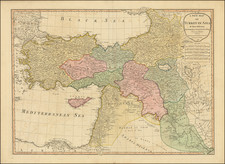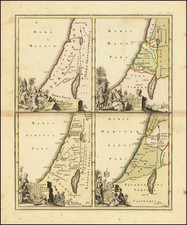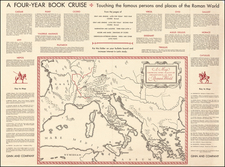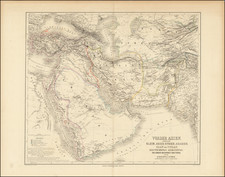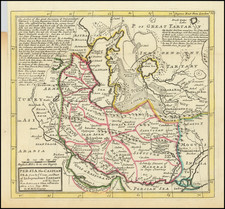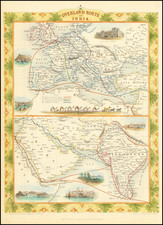Blair's map of the Ancient Holy Land regions is an exquisite piece of historical cartography, illustrating an area of intense historical and cultural significance.
The map is primarily focused on the Holy Land, partitioned into twelve segments, representing the twelve tribes of Israel. Surrounding regions of prominent historical significance are also meticulously detailed, extending to Cyprus, the Red Sea, Egypt, Mesopotamia, Assyria, and a part of the Arabian Peninsula. As the title suggests. the map not only details the geographic divisions of the Promised Land among the Israelites but also the trajectories of their journeys. The inclusion of the Davidic and Solomonic Empires further hints at the map's coverage of the era of Israelite monarchies, approximately between the 11th and 9th centuries BCE.
The depiction is rich with topographic detail, including cities, deserts, mountains, lakes, and bays. It also delineates various routes, both maritime and overland, tracing pathways of ancient travel and trade. A notable feature is the sea route of the Apostle Paul, presumably marking his missionary journeys, as recorded in the New Testament. These would have taken place during the first century CE, suggesting the map's temporal scope extends beyond the age of Israelite monarchies.
The detailed labeling and inclusion of early or biblical locations make the map a fascinating resource for understanding ancient geography and the intersection of historical events with the land. This level of detail suggests the map was constructed based upon a careful examination of ancient sources, possibly combining biblical accounts with historical records and archaeological findings.
The map, thus, presents a comprehensive view of a landscape steeped in religious and historical narratives, from the time of the Israelite settlement in Canaan through to the time of Paul the Apostle. By integrating these various strands of biblical, geographic, and historical data, the map offers a detailed visualization of the land promised to Abraham and his descendants, as well as the surrounding territories. In doing so, it provides a captivating snapshot of a critical period in the history of the Middle East.
The Davidic and Solomonic Empires refer to the periods of King David's and King Solomon's reigns in ancient Israel, respectively. Their rule is traditionally dated from around 1010 BCE to 931 BCE.
Davidic Empire: King David, the second king of the United Kingdom of Israel and Judah, succeeded King Saul. David's rule is believed to have begun around 1010 BCE, and he is most famous for establishing Jerusalem as the political and religious center of the Jewish people, which earned it the name 'The City of David.'
David's reign was marked by a series of military campaigns that substantially expanded the borders of the kingdom. He defeated the Philistines and various other neighboring tribes and secured Israel's place as a significant power in the region. The empire at this point stretched from the Sinai in Egypt to the Euphrates River in modern-day Iraq.
Solomonic Empire: Solomon, the son of David, ascended to the throne around 970 BCE. His rule was more noted for its peace and prosperity rather than military conquest. Solomon further consolidated his power by forming alliances with surrounding nations, often sealed by marriage to foreign princesses.
One of Solomon's most significant achievements was the construction of the First Temple in Jerusalem, also known as Solomon's Temple. This temple became the central place of worship in Israel and housed the Ark of the Covenant.
Under Solomon, Israel experienced a period of peace, prosperity, and cultural development. He embarked on many building projects, including fortifying the city of Jerusalem, constructing an impressive royal palace, and establishing Israelite cities.
However, Solomon's rule also sowed the seeds of division within the kingdom. His heavy taxation to support his lavish lifestyle and building projects, along with his tolerance of his foreign wives' idolatrous practices, led to discontent among the Israelites.
After Solomon's death around 931 BCE, his son Rehoboam ascended to the throne, but his attempt to maintain his father's heavy tax policies led to the division of the kingdom into the northern Kingdom of Israel and the southern Kingdom of Judah.
The Davidic and Solomonic Empires represent a golden age in the history of ancient Israel, a period of significant territorial expansion, relative peace, and considerable cultural development. However, they also set the stage for the division and subsequent downfall of the united kingdom.









